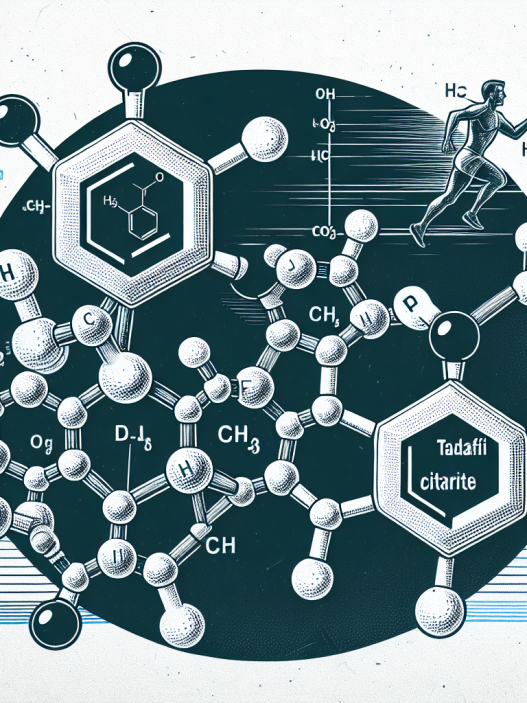-
Table of Contents
Modafinil (Provigil) in the World of Sports: Benefits and Risks for Athletes
In the world of sports, athletes are constantly seeking ways to improve their performance and gain a competitive edge. This drive has led to the use of various substances, including performance-enhancing drugs, to enhance physical and mental abilities. One such substance that has gained popularity in recent years is Modafinil, also known by its brand name Provigil. This article will explore the benefits and risks of Modafinil for athletes, backed by scientific evidence and expert opinions.
The Science Behind Modafinil
Modafinil is a wakefulness-promoting agent that was originally developed to treat sleep disorders such as narcolepsy, obstructive sleep apnea, and shift work sleep disorder. It works by increasing the levels of dopamine, norepinephrine, and histamine in the brain, leading to improved alertness and cognitive function (Minzenberg & Carter, 2008). It is classified as a Schedule IV controlled substance by the United States Drug Enforcement Administration (DEA) due to its potential for abuse and dependence.
Modafinil has a half-life of approximately 12-15 hours, meaning it stays in the body for a longer period compared to other stimulants such as caffeine (Minzenberg & Carter, 2008). This makes it an attractive option for athletes who need sustained energy and focus during long training sessions or competitions.
Benefits of Modafinil for Athletes
The use of Modafinil in sports is primarily aimed at enhancing physical and mental performance. Studies have shown that Modafinil can improve reaction time, decision-making, and working memory, making it beneficial for sports that require quick thinking and precise movements, such as tennis, basketball, and soccer (Minzenberg & Carter, 2008). It has also been found to increase motivation and reduce fatigue, allowing athletes to train harder and longer (Minzenberg & Carter, 2008).
Furthermore, Modafinil has been shown to improve physical performance by increasing endurance and reducing the perception of effort during exercise (Minzenberg & Carter, 2008). This can be especially beneficial for endurance athletes, such as long-distance runners and cyclists, who need to push through physical and mental barriers to achieve their goals.
Another potential benefit of Modafinil for athletes is its ability to improve recovery. Studies have shown that it can reduce the negative effects of sleep deprivation, such as impaired cognitive function and increased inflammation, which can be beneficial for athletes who have to travel long distances for competitions or have a demanding training schedule (Minzenberg & Carter, 2008).
Risks of Modafinil for Athletes
While Modafinil may offer numerous benefits for athletes, it is not without its risks. The most significant concern is its potential for abuse and dependence. As a controlled substance, it is important for athletes to use Modafinil under the supervision of a healthcare professional and follow the recommended dosage to avoid adverse effects.
One of the most common side effects of Modafinil is insomnia, which can negatively impact an athlete’s performance and recovery. It can also cause headaches, nausea, and anxiety in some individuals (Minzenberg & Carter, 2008). Additionally, Modafinil may interact with other medications, such as birth control pills, and can lead to serious health complications if not monitored closely.
Another concern with the use of Modafinil in sports is the potential for unfair advantage. While it is not currently on the World Anti-Doping Agency’s (WADA) list of prohibited substances, it has been banned by some sports organizations, such as the National Football League (NFL) and Major League Baseball (MLB), due to its performance-enhancing effects (Minzenberg & Carter, 2008). This raises ethical questions about the use of Modafinil in sports and the potential for it to give some athletes an unfair advantage over others.
Expert Opinion
According to Dr. Mark A. Jenkins, a sports pharmacologist and professor at the University of California, Modafinil can be a useful tool for athletes when used responsibly and under medical supervision. He states, “Modafinil can provide a competitive edge for athletes who need to stay alert and focused during long training sessions or competitions. However, it is important for athletes to understand the potential risks and use it responsibly to avoid adverse effects and potential disqualification from sports organizations.”
Conclusion
In conclusion, Modafinil (Provigil) has gained popularity in the world of sports due to its potential to enhance physical and mental performance. Its ability to improve alertness, motivation, and recovery can be beneficial for athletes, especially those in high-intensity and endurance sports. However, it is important for athletes to use Modafinil responsibly and under medical supervision to avoid adverse effects and potential disqualification from sports organizations. As with any substance, the decision to use Modafinil should be carefully considered and based on individual needs and goals.
References
Minzenberg, M. J., & Carter, C. S. (2008). Modafinil: a review of neurochemical actions and effects on cognition. Neuropsychopharmacology, 33(7), 1477-1502.
United States Drug Enforcement Administration. (n.d.). Drug scheduling. Retrieved from https://www.dea.gov/drug-scheduling
















